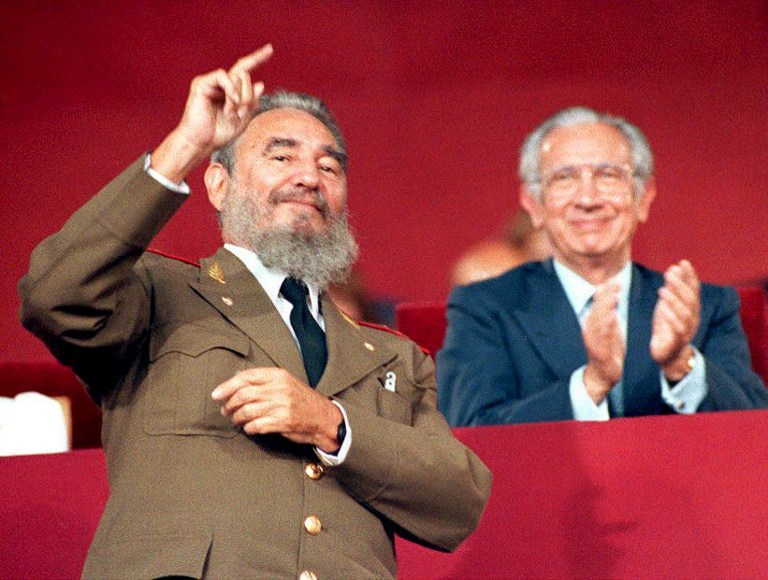
HAVANA, Cuba (AFP) — Cuban revolutionary leader Fidel Castro, a towering figure of 20th century history, died Friday aged 90, his brother, President Raul Castro, announced.
One of the world’s longest-serving rulers and modern history’s most singular characters, he defied successive US administrations and assassination attempts.
He crushed opposition at home to lead the communist Caribbean island through the Cold War before stepping aside in 2006.
He eventually lived to see the historic restoration of diplomatic ties with Washington last year.
“The commander in chief of the Cuban revolution died at 22:29 hours this evening,” the president announced on national television just after midnight Friday (0500 GMT Saturday).
Raul Castro, who took power after his elder brother Fidel was hospitalized in 2006, said that the revolutionary leader’s remains will be cremated early on Saturday, “in compliance with his expressed will.”

Cuban revolutionary icon Fidel Castro died late on November 25, 2016 in Havana, his brother, President Raul Castro, announced on national television.
/ AFP PHOTO / IOPP / Alberto MARTIN
– Political survivor –
The bearded, cigar-puffing leader, renowned for trademark army fatigues and hours-long public tirades, grabbed power in a January 1, 1959 revolution.
Living by the slogan “socialism or death,” he kept the faith to the end, even as the Cold War came and went.
His rule endured numerous assassination attempts and the disastrous US-backed Bay of Pigs invasion attempt in 1961.
“If I am considered a myth, the United States deserves the credit,” he said in 1988.
Castro was at the center of the Cuban Missile Crisis in 1962, as the world stood on the brink of nuclear war until the Soviet Union blinked in its bid to station strategic missiles on Cuban soil.
Well into his old age, Castro unleashed furious diatribes against Washington until he was slowed by surgery in July 2006.
– Revolution –
An energetic symbol of defiance for developing countries and a driving force behind the Non-Aligned Movement, Castro proved even a small sovereign nation could thumb its nose at the world’s biggest superpower.
Born August 13, 1926 to a prosperous Spanish immigrant landowner and a Cuban mother of humble background, Castro was a quick learner and a keen baseball player, reportedly once dreaming of a life in the US big leagues.
His political path was set when he formed a guerrilla opposition to the US-backed government of Fulgencio Batista, who seized power in a 1952 coup.
In 1953 Castro led a small rebel force that attacked a major military base, the Moncada Barracks, in a bid to oust Batista. The drive failed. Castro was put on trial, and in a long, now famous closing self-defense speech said he did not care if was convicted.
“History will absolve me,” he said.
After he was jailed for two years by the Batista regime, he went into exile in Mexico and organized followers for their ultimately triumphant uprising.
It was launched when, on December 2, 1956 they sailed to southeastern Cuba on the ship Granma. Twenty-five months later, they ousted Batista and Castro was named prime minister.
His power undisputed in 1959, the Jesuit-schooled lawyer threw Cuba’s lot in with the Soviet Union, which bankrolled his regime until 1989, when the Eastern Bloc’s collapse sent the economy into a tailspin.
– Ceded power –
He ceded power to Raul, 85, in July 2006 when Fidel underwent intestinal surgery and disappeared from public view.
Castro’s private life was just that. In 1948, he married Mirta Diaz-Balart, who gave him a son, Fidelito. The couple later divorced.
In 1952, Castro met Naty Revuelta, a socialite married to a doctor, and they had a daughter, Alina, in 1956.
He met Celia Sanchez, said to have been the love of his life, in 1957 and remained with her until her death in 1980.
Since the 1980s, Castro’s partner has been Dalia Soto del Valle, with whom he has had five children: Angel, Antonio, Alejandro, Alexis and Alex.
bur-rlp/ch
© 1994-2016 Agence France-Presse







